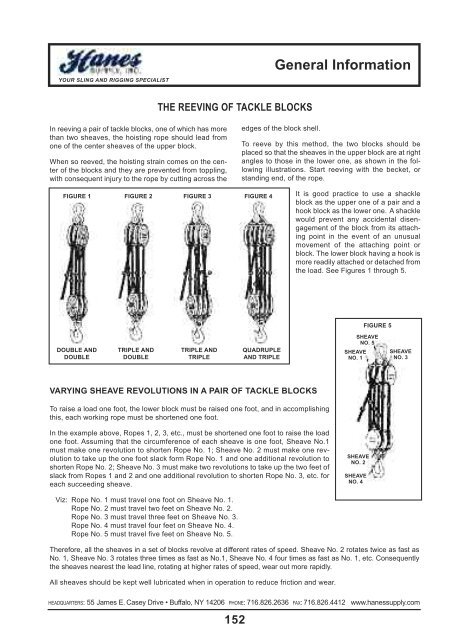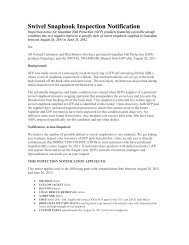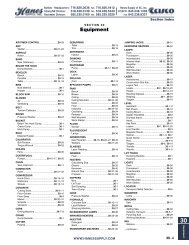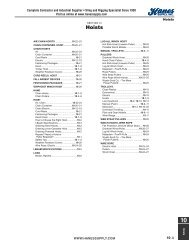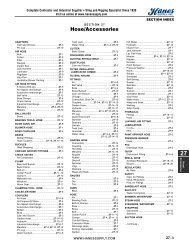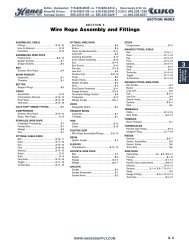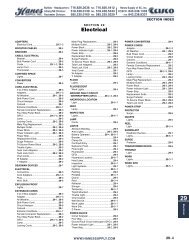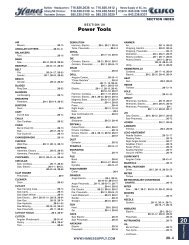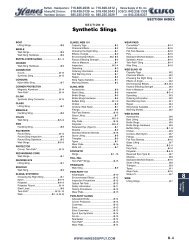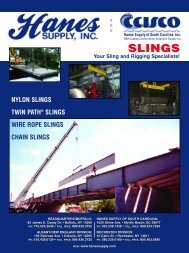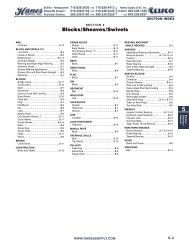twin-path® slings in action - Hanes Supply, Inc
twin-path® slings in action - Hanes Supply, Inc
twin-path® slings in action - Hanes Supply, Inc
- No tags were found...
You also want an ePaper? Increase the reach of your titles
YUMPU automatically turns print PDFs into web optimized ePapers that Google loves.
YOUR SLING AND RIGGING SPECIALISTGeneral InformationTHE REEVING OF TACKLE BLOCKSIn reev<strong>in</strong>g a pair of tackle blocks, one of which has morethan two sheaves, the hoist<strong>in</strong>g rope should lead fromone of the center sheaves of the upper block.When so reeved, the hoist<strong>in</strong>g stra<strong>in</strong> comes on the centerof the blocks and they are prevented from toppl<strong>in</strong>g,with consequent <strong>in</strong>jury to the rope by cutt<strong>in</strong>g across theedges of the block shell.To reeve by this method, the two blocks should beplaced so that the sheaves <strong>in</strong> the upper block are at rightangles to those <strong>in</strong> the lower one, as shown <strong>in</strong> the follow<strong>in</strong>gillustrations. Start reev<strong>in</strong>g with the becket, orstand<strong>in</strong>g end, of the rope.fIGURe 1 fIGURe 2 fIGURe 3 fIGURe 4It is good practice to use a shackleblock as the upper one of a pair and ahook block as the lower one. A shacklewould prevent any accidental disengagementof the block from its attach<strong>in</strong>gpo<strong>in</strong>t <strong>in</strong> the event of an unusualmovement of the attach<strong>in</strong>g po<strong>in</strong>t orblock. The lower block hav<strong>in</strong>g a hook ismore readily attached or detached fromthe load. See Figures 1 through 5.fIGURe 5DoUble anDDoUbletRIPle anDDoUbletRIPle anDtRIPleQUaDRUPleanD tRIPlesHeaVeno. 5sHeaVeno. 1sHeaVeno. 3VaRYInG sHeaVe ReVolUtIons In a PaIR of tackle blocksTo raise a load one foot, the lower block must be raised one foot, and <strong>in</strong> accomplish<strong>in</strong>gthis, each work<strong>in</strong>g rope must be shortened one foot.In the example above, Ropes 1, 2, 3, etc., must be shortened one foot to raise the loadone foot. Assum<strong>in</strong>g that the circumference of each sheave is one foot, Sheave No.1must make one revolution to shorten Rope No. 1; Sheave No. 2 must make one revolutionto take up the one foot slack form Rope No. 1 and one additional revolution toshorten Rope No. 2; Sheave No. 3 must make two revolutions to take up the two feet ofslack from Ropes 1 and 2 and one additional revolution to shorten Rope No. 3, etc. foreach succeed<strong>in</strong>g sheave.sHeaVeno. 2sHeaVeno. 4Viz: Rope No. 1 must travel one foot on Sheave No. 1.Rope No. 2 must travel two feet on Sheave No. 2.Rope No. 3 must travel three feet on Sheave No. 3.Rope No. 4 must travel four feet on Sheave No. 4.Rope No. 5 must travel five feet on Sheave No. 5.Therefore, all the sheaves <strong>in</strong> a set of blocks revolve at different rates of speed. Sheave No. 2 rotates twice as fast asNo. 1, Sheave No. 3 rotates three times as fast as No.1, Sheave No. 4 four times as fast as No. 1, etc. Consequentlythe sheaves nearest the lead l<strong>in</strong>e, rotat<strong>in</strong>g at higher rates of speed, wear out more rapidly.All sheaves should be kept well lubricated when <strong>in</strong> operation to reduce friction and wear.HEADQUARTERS: 55 James E. Casey Drive • Buffalo, NY 14206 PHONE: 716.826.2636 FAX: 716.826.4412 www.hanessupply.com152


